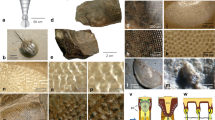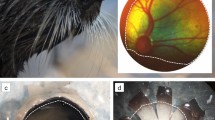Abstract
Scallop pallial eyes have been the most studied optical system in bivalve mollusks. Despite recent advances in our understanding of the function and evolution of scallop eyes, little attention has been focused on eye development and early visual performance. Here, the anatomy and development of pallial eyes were investigated in the scallop Nodipecten nodosus (Linnaeus, 1758) by means of integrative microscopy techniques (i.e., light, electron, and confocal microscopy). After metamorphosis, juvenile scallops bear small papillae that rapidly transform into minute ocular organs on the middle mantle fold. The distal epithelium gradually becomes pigmented, except for the cornea formed at the distal center of the eye. Internally, the optic vesicle comprises undifferentiated cells in the distal region, while mirror plates are secreted at the base of the eye, next to pigmented cells. Within the undifferentiated cell mass, the proximal retina is the first to be formed, followed by the distal retina and then by the lens. In this respect, the late development of the scallop lens from retina precursor cells may represent a unique condition among animal eyes. Adult eyes are characterized by large pigment distribution in the epithelium, tall columnar cornea, and lens above a slightly curved double retina. Whereas the pallial eyes from adult scallops are a complex visual system based on a mirror mechanism to form a focused image on the retina, early eye condition suggests a simple degree of directional photoreception, with no spatial vision.






Similar content being viewed by others
References
Adal MN, Morton B (1973) The fine structure of the pallial eyes of Laternula truncata (Bivalvia: Anomalodesmata: Pandoracea). J Zool 170:533–556
Alejandrino A, Puslednik L, Serb JM (2011) Convergent and parallel evolution in life habit of the scallops (Bivalvia: Pectinidae). BMC Evol Biol 11:164
Barber VC, Land MF (1967) The eye of the cockle, Cardium edule: anatomical and physiological investigations. Cell Mol Life Sci 23(8):677–678
Barber VC, Evans EM, Land MF (1967) The fine structure of the eye of the mollusc Pecten maximus. Z Zellforsch Mik Ana 76:295–312
Boyle PR (1972) The aesthetes of chitons. 1. Role in the light response of whole animals. Mar Behav Physiol 1:171–184
Butcher EO (1930) The formation, regeneration, and transplantation of eyes in Pecten (Gibbus borealis). Biol Bull 59(2):154–164
Charlton-Perkins M, Brown NL, Cook TA (2011) The lens in focus: a comparison of lens development in Drosophila and vertebrates. Mol Genet Genomics 286:189–213
Ciocco NF (1998) Anatomía de la “vieira tehuelche”, Aequipecten tehuelchus (d’Orbigny, 1846) (=Chlamys tehuelcha). IV, Sistema nervioso y estructuras sensoriales (Bivalvia, Pectinidae). Rev Biol Mar Oceanogr 33(1):25–42
Dakin WJ (1910) The eye of Pecten. Q J Microsc Sci 55:49–112
Dakin WJ (1928) The eyes of Pecten, Spondylus, Amussium and allied Lamellibranchs, with a short discussion on their evolution. Proc R Soc Lond B Biol 103(725):355–365
Drew GA (1906) The habits, anatomy, and embryology of the giant scallop. (Pecten tenuicostatus, Mighels). Maine, Orono, pp 1–71
Fitzgerald WJ (1975) Movement patterns and phototactic response of Mopalia ciliata and Mopalia muscosa in Marin County, California. Veliger 18:37–39
Giribet G (2008) Bivalvia. In: Ponder W, Lindberg D (eds) Phylogeny and evolution of the Mollusca. University of California Press, California, pp 105–141
Hamilton PV, Koch KM (1996) Orientation toward natural and artificial grassbeds by swimming bay scallops, Argopecten irradians Lamarck, 1819. J Exp Mar Biol Ecol 199:79–88
Hanlon RT, Shashar N (2003) Aspects of the sensory ecology of cephalopods. In: Collin SP, Marshall NJ (eds) Sensory processing in aquatic environments. Springer, New York, pp 266–282
Hay ED (1980) Development of the vertebrate cornea. In: Bourne GH, Danielli JF (eds) International review of cytology. Academic Press, New York, pp 263–316
Hayami I (1991) Living and fossil scallop shells as airfoils: an experimental study. Paleobiology 17:1–18
Jonasova K, Kozmik Z (2008) Eye evolution: lens and cornea as an upgrade of animal visual system. Semin Cell Dev Biol 19:71–81
Krohn A (1840) Über augenähnliche Organe bei Pecten und Spondylus. Arch Anat Physiol Wiss Med 7:371–386
Küpfer M (1916) Entwicklungsgeschichtliche und neuro-histologische Beiträge zur Kenntnis der Sehorgane am Mantelrande der Pecten-Arten: mit anschliessenden vergleichend-anatomischen Betrachtungen. Fischer, Jena
Land MF (1965) Image formation by a concave reflector in the eye of the scallop, Pecten maximus. J Physiol 179:138–153
Land MF (1966) A multilayer interference reflector in the eye of the scallop, Pecten maximus. J Exp Biol 45:433–447
Land MF (1972) The physics and biology of animal reflectors. Prog Biophys Mol Biol 24:75–106
Land MF, Nilsson DE (2012) Animal eyes. Oxford University Press, Oxford
Malkowsky Y, Götze MC (2014) Impact of habitat and life trait on character evolution of pallial eyes in Pectinidae (Mollusca: Bivalvia). Org Divers Evol 14:173–185
Malkowsky Y, Jochum A (2014) Three-dimensional reconstructions of pallial eyes in Pectinidae (Mollusca: Bivalvia). Acta Zool (Stockholm) 1–7
Marian JEAR (2012) Spermatophoric reaction reappraised: novel insights into the functioning of the loliginid spermatophore based on Doryteuthis plei (Mollusca: Cephalopoda). J Morphol 273:248–278
Morton B (1987) The pallial photophores of Barbatia virescens (Bivalvia: Arcacea). J Mollus Stud 53:241–243
Morton B (2000a) The pallial eyes of Ctenoides floridanus (Bivalvia: Limoidea). J Mollus Stud 66:449–455
Morton B (2000b) The function of pallial eyes within the Pectinidae, with a description of those present in Patinopecten yessoensis. In: Harper EM, Taylor JD, Crame JA (eds) The evolutionary biology of the Bivalvia. Special Publications, 177. Geological Society, London, pp 247–255
Morton B (2008) The evolution of eyes in the Bivalvia: New insights. Am Malacol Bull 26(1/2):35–45
Moseley HN (1885) On the presence of eyes in the shells of certain Chitonidae, and on the structure of these organs. Q J Microsc Sci 25:37–60
Muntz WRA, Raj U (1984) On the visual system of Nautilus pompilius. J Exp Biol 109:253–263
Nilsson DE (1994) Eyes as optical alarm systems in fan worms and ark clams. Philos Trans R Soc Lond B Biol Sci 346:195–212
Nilsson DE (2013) Eye evolution and its functional basis. Vis Neurosci 30:5–20
Pairett AN, Serb JM (2013) De novo assembly and characterization of two transcriptomes reveal multiple light-mediated functions in the scallop eye (Bivalvia: Pectinidae). PLoS One 8(7):e69852
Patten W (1887) Eyes of molluscs and arthropods. J Morphol 1(1):67–92
Poli GS (1971) Testacea utriusque siciliae eorumque historia et anatome tabulis aeneis illustrata, vol II. Ex Regio Typographeio (Ducali), Parma
Puslednik L, Serb JM (2008) Molecular phylogenetics of the Pectinidae (Mollusca: Bivalvia) and effect of increased taxon sampling and outgroup selection on tree topology. Mol Phylogenet Evol 48:1178–1188
Salvini-Plawen LV (2008) Photoreception and the polyphyletic evolution of photoreceptors (with special reference to Mollusca). Am Malacol Bull 26(1/2):83–100
Sastry AN (1965) The development and external morphology of pelagic larval and postlarval stages of the bay scallop, Aequipecten irradians concentricus Say, reared in the laboratory. Bull Mar Sci 15(2):417–435
Serb JM (2008) Toward developing models to study the disease, ecology, and evolution of the eye in Mollusca. Am Malacol Bull 26(1/2):3–18
Serb JM, Eernisse DJ (2008) Charting evolution’s trajectory: using molluscan eye diversity to understand parallel and convergent evolution. Evol Educ Outreach 1:439–447
Serb JM, Alejandrino A, Otárola-Castillo E, Adams DC (2011) Morphological convergence of shell shape in distantly related scallop species (Mollusca: Pectinidae). Zool J Linnean Soc 163(2):571–584
Serb JM, Porath-Krause AJ, Pairett AN (2013) Uncovering a gene duplication of the photoreceptive protein, opsin, in scallops (Bivalvia: Pectinidae). Integr Comp Biol 53:68–77
Speiser DI, Johnsen S (2008) Comparative morphology of the concave mirror eyes of scallops (Pectinoidea). Am Malacol Bull 26(1/2):27–33
Speiser DI, Eernisse DJ, Johnsen S (2011a) A chiton uses aragonite lenses to form images. Curr Biol 21:665–670
Speiser DI, Loew ER, Johnsen S (2011b) Spectral sensitivity of the concave mirror eyes of scallops: potential influences of habitat, self-screening and longitudinal chromatic aberration. J Exp Biol 214:422–431
Stasek CR, McWilliams WR (1973) The comparative morphology and evolution of molluscan mantle edge. Veliger 16:1–19
Viana MG, Rocha-Barreira CA (2007) The sensorial structures of Spondylus americanus Hermann, 1781 (Mollusca: Bivalvia, Spondylidae). Braz Arch Biol Technol 50(5):815–819
Waller TR (1980) Scanning electron microscopy of shell and mantle in the order Arcoida (Mollusca: Bivalvia). Smithson Contrib Zool 313:1–58
Waller TR (2006) Phylogeny of families in the Pectinoidea (Mollusca: Bivalvia): importance of the fossil record. In Bieler R (ed) Bivalvia—a look at the Branches. Zool J Linnean Soc, vol 148, pp 313–342
West JA, Sivak JG, Doughty MJ (1995) Microscopical evaluation of the crystalline lens of the squid (Loligo opalescens) during embryonic development. Exp Eye Res 60(1):19–35
Wilkens LA (1986) The visual system of the giant clam Tridacna: behavioral adaptation. Biol Bull 170:393–408
Wilkens LA (2006) Neurobiology and behaviour of the scallop. In: Shumway SE, Parsons GJ (eds) Scallops: biology, ecology, and aquaculture. Elsevier, New York, pp 317–356
Yonge CM (1983) Symmetries and the role of the mantle margins in the bivalve Mollusca. Malacol Rev 16:1–10
Young JZ (1971) The anatomy of the nervous system of Octopus vulgaris. Clarendon Press, Oxford
Zieger MV, Meyer-Rochow VB (2008) Understanding the cephalic eyes of pulmonate gastropods: a review. Am Malacol Bull 26(1/2):47–66
Acknowledgments
The authors acknowledge funding provided by “Fundação de Amparo à Pesquisa do Estado de São Paulo” (FAPESP, undergraduate and graduate fellowships and research funding; 2010/17000-5; 2012/11708-1; 2013/17685-6). This study is part of the first author’s Master’s dissertation through the Graduate Program in Zoology of the “Departamento de Zoologia—IB-USP”. The authors thank the following laboratories and institutions, which provided the necessary facilities for the development of this study: Centro de Biologia Marinha da USP (logistic support for animal collection and maintenance), Laboratório de Biologia Celular, IB-USP (electron microscopy facilities). Dr. Alvaro E. Migotto provided invaluable assistance during in vivo studies, and Dr. André C. Morandini provided support during image acquisition from histological data. The authors also thank two anonymous reviewers for valuable comments that helped to improve the manuscript.
Author information
Authors and Affiliations
Corresponding author
Additional information
Communicated by A. Schmidt-Rhaesa.
Appendix
Appendix
Species list with nomenclatural author and year
Amusium balloti (Bernardi, 1861)
Argopecten gibbus (Linnaeus, 1758)
Argopecten irradians (Lamarck, 1819)
Aequipecten tehuelchus (d’Orbigny, 1842)
Chlamys islandica (O. F. Müller, 1776)
Chlamys hastata (G. B. Sowerby II, 1842)
Chlamys rubida (Hinds, 1845)
Crassadoma gigantea (J.E. Gray, 1825)
Flexopecten flexuosus (Poli, 1795)
Flexopecten glaber (Linnaeus, 1758)
Nodipecten nodosus (Linnaeus, 1758)
Palliolum incomparabile (Risso, 1826)
Patinopecten yessoensis (Jay, 1857)
Pecten maximus (Linnaeus, 1758)
Placopecten magellanicus (Gmelin, 1791)
Spondylus americanus (Hermann, 1781)
Rights and permissions
About this article
Cite this article
Audino, J.A., Marian, J.E.A.R., Wanninger, A. et al. Development of the pallial eye in Nodipecten nodosus (Mollusca: Bivalvia): insights into early visual performance in scallops. Zoomorphology 134, 403–415 (2015). https://doi.org/10.1007/s00435-015-0265-8
Received:
Revised:
Accepted:
Published:
Issue Date:
DOI: https://doi.org/10.1007/s00435-015-0265-8




